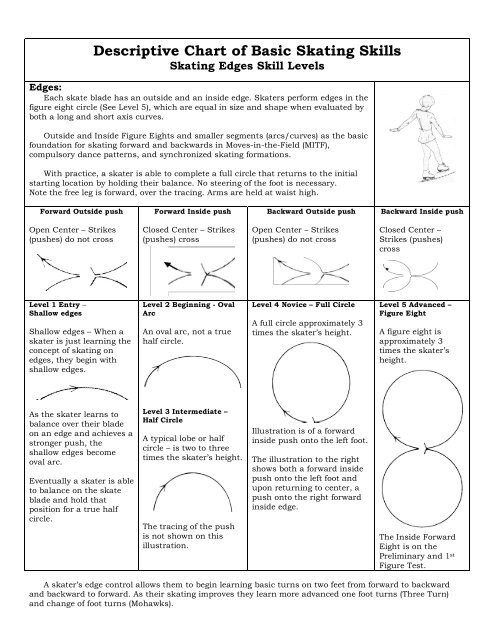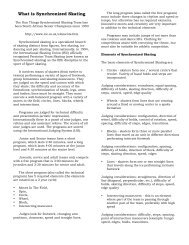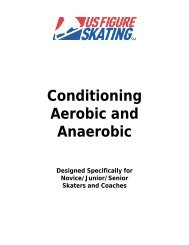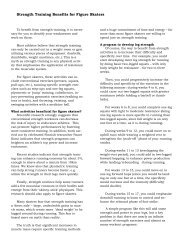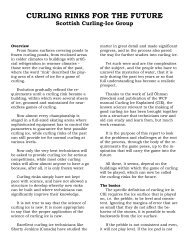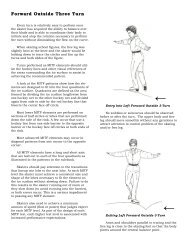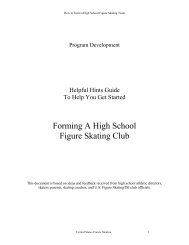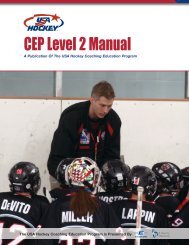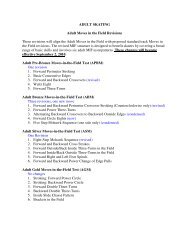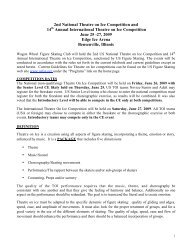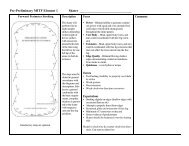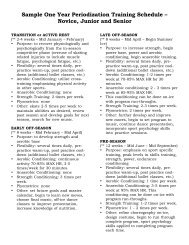Descriptive Chart of Basic Skating Skills - Ice skating resources
Descriptive Chart of Basic Skating Skills - Ice skating resources
Descriptive Chart of Basic Skating Skills - Ice skating resources
You also want an ePaper? Increase the reach of your titles
YUMPU automatically turns print PDFs into web optimized ePapers that Google loves.
<strong>Descriptive</strong> <strong>Chart</strong> <strong>of</strong> <strong>Basic</strong> <strong>Skating</strong> <strong>Skills</strong><br />
<strong>Skating</strong> Edges Skill Levels<br />
Edges:<br />
Each skate blade has an outside and an inside edge. Skaters perform edges in the<br />
figure eight circle (See Level 5), which are equal in size and shape when evaluated by<br />
both a long and short axis curves.<br />
Outside and Inside Figure Eights and smaller segments (arcs/curves) as the basic<br />
foundation for <strong>skating</strong> forward and backwards in Moves-in-the-Field (MITF),<br />
compulsory dance patterns, and synchronized <strong>skating</strong> formations.<br />
With practice, a skater is able to complete a full circle that returns to the initial<br />
starting location by holding their balance. No steering <strong>of</strong> the foot is necessary.<br />
Note the free leg is forward, over the tracing. Arms are held at waist high.<br />
Forward Outside push<br />
Forward Inside push<br />
Backward Outside push<br />
Backward Inside push<br />
Open Center – Strikes<br />
(pushes) do not cross<br />
Closed Center – Strikes<br />
(pushes) cross<br />
Open Center – Strikes<br />
(pushes) do not cross<br />
Closed Center –<br />
Strikes (pushes)<br />
cross<br />
Level 1 Entry –<br />
Shallow edges<br />
Shallow edges – When a<br />
skater is just learning the<br />
concept <strong>of</strong> <strong>skating</strong> on<br />
edges, they begin with<br />
shallow edges.<br />
Level 2 Beginning - Oval<br />
Arc<br />
An oval arc, not a true<br />
half circle.<br />
Level 4 Novice – Full Circle<br />
A full circle approximately 3<br />
times the skater’s height.<br />
Level 5 Advanced –<br />
Figure Eight<br />
A figure eight is<br />
approximately 3<br />
times the skater’s<br />
height.<br />
As the skater learns to<br />
balance over their blade<br />
on an edge and achieves a<br />
stronger push, the<br />
shallow edges become<br />
oval arc.<br />
Eventually a skater is able<br />
to balance on the skate<br />
blade and hold that<br />
position for a true half<br />
circle.<br />
Level 3 Intermediate –<br />
Half Circle<br />
A typical lobe or half<br />
circle – is two to three<br />
times the skater’s height.<br />
The tracing <strong>of</strong> the push<br />
is not shown on this<br />
illustration.<br />
Illustration is <strong>of</strong> a forward<br />
inside push onto the left foot.<br />
The illustration to the right<br />
shows both a forward inside<br />
push onto the left foot and<br />
upon returning to center, a<br />
push onto the right forward<br />
inside edge.<br />
The Inside Forward<br />
Eight is on the<br />
Preliminary and 1 st<br />
Figure Test.<br />
A skater’s edge control allows them to begin learning basic turns on two feet from forward to backward<br />
and backward to forward. As their <strong>skating</strong> improves they learn more advanced one foot turns (Three Turn)<br />
and change <strong>of</strong> foot turns (Mohawks).
<strong>Skating</strong> Turns Skill Levels<br />
Turns<br />
Turns involve turning from forward to backwards and backwards to forward. The can be performed<br />
entirely on one foot or involving a change <strong>of</strong> foot.<br />
Starting from a deep moving curve, the skater turns backward and holds their free leg <strong>of</strong>f the ice. There<br />
should be continuous movement over the ice without any loss <strong>of</strong> speed or control, wobble or subcurves, while<br />
controlling the free leg as they glide back to the center.<br />
The object is to perform the turns with no loss <strong>of</strong> flow, good upper body control, and no change <strong>of</strong> edge or<br />
scraping <strong>of</strong> the turn. It takes considerable practice to master the more difficult turns such as brackets, loops,<br />
rockers, counters, Mohawks, Choctaws, and twizzles, which compose the high MITF and compulsory Dance<br />
tests.<br />
The Forward3-Turn<br />
Level 1 Entry –<br />
No glide<br />
Level 2 Beginning –<br />
Glide on Shallow Arc<br />
Level 4 Novice –<br />
Glide on Full Circle<br />
Level 5 Advanced –<br />
Glide on Figure Eight<br />
The skater essentially<br />
starts from a standing<br />
position and turns<br />
backward and<br />
immediately puts their<br />
other foot (free leg) down.<br />
There is relatively little<br />
flow into and out <strong>of</strong> the<br />
turn.<br />
This may be practiced<br />
with the skater starting<br />
next to the barrier with a<br />
hand on the barrier for<br />
confidence.<br />
Starting from a moving<br />
position, the skater<br />
turns backward and<br />
holds their free leg <strong>of</strong>f<br />
the ice. There should be<br />
a continuation <strong>of</strong><br />
movement over the ice.<br />
Level 3 Intermediate –<br />
Glide on Half Circle<br />
A typical lobe or half<br />
circle – is two to three<br />
times the skater’s height.<br />
A full circle is<br />
approximately 3 times the<br />
skater’s height.<br />
Starting from a deep<br />
moving curve, the skater<br />
turns backward and<br />
holds their free leg <strong>of</strong>f the<br />
ice.<br />
A figure eight is<br />
approximately 3 times<br />
the skater’s height<br />
The Three’s to Center is<br />
on the 1 st Figure Test.<br />
There should be<br />
continuous movement<br />
over the ice without any<br />
loss <strong>of</strong> speed or control<br />
and the ability to<br />
maintain the back edge<br />
back returning to the<br />
circle’s center.<br />
Starting from a standing<br />
start, the skater pushes<br />
<strong>of</strong>f and turns backward<br />
at the long axis (top <strong>of</strong><br />
the circle).<br />
Beginner skaters most <strong>of</strong>ten skate in the<br />
counter clockwise direction; this direction becomes<br />
stronger and more comfortable for them to<br />
perform.<br />
Skaters generally practice in the CCW direction<br />
and the forward clockwise direction does not<br />
develop the same strength and control as the<br />
counter clockwise direction.<br />
This is a serious bilateral weakness for both<br />
hockey and figure/free skaters. Since speed<br />
<strong>skating</strong> (long and short track) always skate in the<br />
counter clockwise direction, the lack <strong>of</strong> bilateral<br />
crossover skill development does not present a<br />
problem for speed skaters.
Forward Crossovers Skill Levels<br />
Forward Crossovers<br />
The body should begin in an aligned position with the feet in a parallel position with the hips and<br />
shoulders squared.<br />
The right arm should extend forward at waist height. Your left arm will be extended be behind at the same<br />
height over the tracing. Relax and push your shoulders down. The shoulders should be directly over the hips.<br />
Skaters commonly mistake leaning forward for increasing their speed. It is a major mistake to lean forward at<br />
the waist.<br />
Bend both knees and push <strong>of</strong>f from the entire inside edge <strong>of</strong> your right blade without pushing from the<br />
toepick! The toepicks <strong>of</strong> the blade are designed to assist in jumping – not to push <strong>of</strong>f on an edge, especially<br />
crossovers.<br />
It is essential that the skater master the ability to achieve equal power from BOTH feet. The stroking<br />
should be an even tempo/rhythm in both clockwise and counter clockwise directions. The skater should lean<br />
and look into the center <strong>of</strong> the circle.<br />
Level 1 Entry –<br />
Forward Stepovers<br />
Limited speed. Stiff<br />
body and very limited<br />
knee bend.<br />
Level 2 Beginning –<br />
Forward Crossovers<br />
Fair speed. Fair upper body<br />
posture and control.<br />
Moderate knee bend.<br />
Starting to lean into circle.<br />
Level 3<br />
Intermediate –<br />
Forward Crossovers<br />
Good speed. Good<br />
upper body posture and<br />
control. Good knee<br />
bend. Good lean into<br />
circle.<br />
Level 4 Novice –<br />
Forward Crossovers<br />
Very good speed. Good<br />
upper body posture and<br />
control. Good knee<br />
bend. Good lean into<br />
circle.<br />
Level 5 Advanced –<br />
Forward Crossovers<br />
Full speed. Excellent<br />
upper body posture and<br />
control. Deep knee<br />
bend. Excellent lean into<br />
circle.<br />
Backward Crossovers Skill Levels<br />
Backward Crossovers<br />
Use a hockey circle as a guide, bending your knees. Look into the circle to be sure there’s no one you will<br />
run into. Your arms should be waist level with the lead shoulder being slightly lower. The right arm will lead<br />
and the left arm will be over the tracing.<br />
Start with the feet parallel feet. Use your left inside edge to perform the first push to start moving<br />
backwards on the right outside edge and gliding while the left foot crossover in <strong>of</strong> the right foot. The right foot<br />
extends backwards over the arc to achieve maximum power.<br />
Some skater performs their crossovers by only a crossing behind motion <strong>of</strong> the right foot, which results in<br />
a jerky movement with the right foot providing <strong>of</strong> the work with the pulling stroke. It is important to bend<br />
your knees and lean into the circle with your upper body in alignment.<br />
It is essential that the skater master the ability to achieve equal power from BOTH feet. The stroking<br />
should be an even tempo/rhythm in both clockwise and counter clockwise directions. The skater should lean<br />
into the center <strong>of</strong> the circle and look in the direction <strong>of</strong> travel.<br />
Level 1 Entry –<br />
Back Stepovers<br />
Level 2 Beginning –<br />
Back Crossovers<br />
Level 3 Intermediate<br />
– Back Crossovers<br />
Level 4 Novice –<br />
Back Crossovers<br />
Level 5 Advanced –<br />
Back Crossovers<br />
Limited speed. Stiff<br />
body and very limited<br />
knee bend.<br />
Fair speed. Fair upper<br />
body posture and control.<br />
Moderate knee bend.<br />
Starting to lean into<br />
circle.<br />
Moderate speed. Good<br />
upper body posture and<br />
control. Good knee bend.<br />
Good lean into circle.<br />
Good speed. Good<br />
upper body posture and<br />
control. Good knee<br />
bend. Good lean into<br />
circle.<br />
Full speed. Excellent<br />
upper body posture and<br />
control. Deep knee<br />
bend. Excellent lean into<br />
circle.<br />
Learning to skate fast is not very useful if you<br />
are unable to execute a controlled stop at a high<br />
speed. After a skater learns to skate forward in a<br />
straight line, they must learn how to skate in a<br />
circle.
This process is called crossovers. In public<br />
sessions and most free <strong>skating</strong> sessions skater are<br />
traveling in the counter clockwise direction, which<br />
is the direction right-handed skaters, feel more<br />
comfortable.<br />
Hockey and figure skaters should be able to<br />
perform forward and backward crossovers in both<br />
directions in a large figure 8 at full power.<br />
References:<br />
<strong>Ice</strong> <strong>Skating</strong> Lesson on Crossovers Crossovers are<br />
the way skaters move around corners and across<br />
the ends <strong>of</strong> a rink. Mastering forward crossovers<br />
make a figure skater better and faster.<br />
Figure <strong>skating</strong> techniques: learning crossovers<br />
Figure <strong>skating</strong> techniques: crossovers are literally<br />
what get you around the corners at the rink.<br />
They're important to learn as they're used so<br />
frequently<br />
Snowplow Stops Skill Levels<br />
Snowplow Stop<br />
The snowplow stop is performed with the toes <strong>of</strong> the skates pointing forming a pigeon-toed position. The<br />
beginner skates slowly in a forward direction. While gliding, bend the knees and lean backwards slightly while<br />
pushing the skates apart as the feet form a pigeon-toed position. The blades will skid and produce the friction<br />
necessary to come to a complete stop.<br />
Skaters need to be able to stop in CW and CCW directions when going backward as well as forward.<br />
Level 1 Entry –<br />
Forward Two Foot<br />
Snowplow Stop<br />
Limited speed. Stiff<br />
body and very limited<br />
knee bend. Bending<br />
forward at waist<br />
when stopping.<br />
Level 2 Beginning –<br />
Forward Two Foot<br />
Snowplow Stop<br />
Fair speed. Fair upper<br />
body posture and<br />
control. Moderate<br />
knee bend. Starting to<br />
stand upright when<br />
stopping.<br />
Level 3 Intermediate –<br />
Forward Left and right<br />
Foot One Foot<br />
Snowplow Stop<br />
Moderate speed. Good<br />
upper body posture and<br />
control. Good knee bend.<br />
Good lean back when<br />
stopping.<br />
Level 4 Novice –<br />
Backward Left Foot<br />
One Foot Snowplow<br />
Stop CW Direction<br />
Good speed. Good upper<br />
body posture and<br />
control. Good knee<br />
bend. Good lean back<br />
when stopping.<br />
Level 5 Advanced –<br />
Backward Right Foot<br />
One Foot Snowplow<br />
Stop CCW Direction<br />
Full speed. Excellent<br />
upper body posture and<br />
control. Deep knee<br />
bend. Excellent lean<br />
back when stopping.<br />
T Stops Skill Levels<br />
T-Stop<br />
The T-Stop is performed with the skates forming a T-position as the name implies.<br />
To execute a t-stop, you should begin <strong>skating</strong> slowly in a forward direction. Turn one<br />
skate at a 45-degree angle and drag it behind the other skate.<br />
Position the instep <strong>of</strong> the skate that is being dragged at the heel <strong>of</strong> the lead skate.<br />
The shoulders should remain level and at a 90 degree angle to the direction <strong>of</strong> travel.<br />
Arms should be out to the side at approximately waist level.<br />
To complete a controlled stop, it is necessary to lean back slightly and shift the<br />
body weight to the rear skate that is being dragged.<br />
Level 1 Entry – Right<br />
Foot T-Stop<br />
Limited speed. Stiff<br />
body and very limited<br />
knee bend. Bending<br />
forward at waist when<br />
stopping.<br />
Level 2 Beginning<br />
– Left Foot T-Stop<br />
Fair speed. Fair upper<br />
body posture and<br />
control. Moderate<br />
knee bend. Starting to<br />
stand upright when<br />
stopping.<br />
Level 3 Intermediate<br />
– Backward Right<br />
Foot T-Stop<br />
Moderate speed. Good<br />
upper body posture and<br />
control. Good knee bend.<br />
Good lean back when<br />
stopping<br />
Level 4 Novice –<br />
Backward Left Foot<br />
T-Stop CW Direction<br />
Good speed. Good upper<br />
body posture and control.<br />
Good knee bend. Good<br />
lean back when stopping.<br />
Level 5 Advanced –<br />
Backward Left Foot<br />
T-Stop CCW<br />
Direction<br />
Full speed. Excellent<br />
upper body posture and<br />
control. Deep knee<br />
bend. Excellent lean<br />
back when stopping.
Hockey Stops Skill Levels<br />
Hockey Stop<br />
Even figure skaters should learn how to perform a hockey-stop. This stop allows skaters to abruptly stop,<br />
even when <strong>skating</strong> fast. Hockey players frequently use this stop. Turning both skates in the same direction,<br />
parallel to the direction <strong>skating</strong>, performs the stop. <strong>Ice</strong> skaters should learn the hockey-stop in both forward<br />
and backward, clockwise and counter clockwise directions.<br />
Execution <strong>of</strong> a hockey-stop begins by <strong>skating</strong> forward or backward at a moderate speed in a CCW and CW<br />
direction. Arms should be at waist level forming a straight line as if holding a hockey stick. The skates should<br />
be slightly apart with knees bent. The stop is imitated by simultaneously twisting the shoulders in one<br />
direction and the feet in the opposite direction.<br />
Depending on the turning direction <strong>of</strong> the body, the leading skate will be on an outside or inside edge. The<br />
trailing foot will be on the opposite edge. The hips and skates are turned sideways; the head, chest and<br />
stomach should be facing the <strong>skating</strong> direction.<br />
To complete a controlled stop, the head should be looking straight ahead and upper body should be<br />
directly inline with the knees and hips, leaning back to counter act falling forward and the body stops<br />
abruptly.<br />
Level 1 Entry –<br />
Hockey Stop -<br />
Forward and Back<br />
Emerging stopping<br />
skill with low<br />
power from<br />
forward crossovers<br />
in CC direction.<br />
Limited speed. Stiff<br />
body and very limited<br />
knee bend. Bending<br />
forward at waist when<br />
stopping.<br />
Level 2 Beginning –<br />
Hockey Stop -<br />
Forward and Back<br />
Increasing forward<br />
speed and stopping<br />
in both CCW and<br />
CW directions.<br />
Fair speed. Fair upper<br />
body posture and<br />
control. Moderate knee<br />
bend. Starting to stand<br />
upright when stopping.<br />
Level 3 Intermediate –<br />
Hockey Stop –<br />
Forward and Back<br />
Increasing backward<br />
speed and stopping<br />
in both CCW and CW<br />
directions.<br />
Moderate speed. Good<br />
upper body posture and<br />
control. Good knee bend.<br />
Good lean back when<br />
stopping.<br />
Level 4 Novice –<br />
Hockey Stop with<br />
hockey stick -<br />
Forward and Back<br />
Increasing forward<br />
and backward<br />
speed; stopping in<br />
both CCW and CW<br />
directions.<br />
Good speed. Good<br />
upper body posture and<br />
control. Good knee<br />
bend. Good lean back<br />
when stopping.<br />
Level 5 Advanced -<br />
Hockey Stop in full<br />
hockey gear and<br />
stick - Forward and<br />
Back<br />
Increasing forward<br />
and backward<br />
speed; stopping in<br />
both CCW and CW<br />
directions.<br />
Full speed. Excellent<br />
upper body posture and<br />
control. Deep knee bend.<br />
Excellent lean back when<br />
stopping.<br />
<strong>Descriptive</strong> <strong>Chart</strong> References:<br />
Snowplow Stop - <strong>Ice</strong> <strong>Skating</strong> Move Snowplow<br />
Stop Stopping on the ice is essential for every<br />
figure skater. This is the first and easiest stop a<br />
skater should master.<br />
http://figure<strong>skating</strong>.about.com/od/figure<strong>skating</strong>techniq<br />
ue/ht/snowplow.htm<br />
<strong>Ice</strong> <strong>Skating</strong> Tips The snowplow stop is another<br />
stop that is great for beginner ice skaters to learn.<br />
The snowplow stop got its name because <strong>of</strong> the ice<br />
shavings that buildup.<br />
http://www.<strong>skating</strong>fitness.com/<strong>Ice</strong><strong>Skating</strong>-<strong>Ice</strong>-<strong>Skating</strong>-<br />
Tips.htm<br />
How to <strong>Ice</strong> Skate: How to do a T-Stop on <strong>Ice</strong><br />
Skates T-stops in ice <strong>skating</strong> involve stopping<br />
with your ice skates in a T position.<br />
http://www.youtube.com/watchv=S8CWdQyYxzc<br />
T-Stop - <strong>Ice</strong> <strong>Skating</strong> Stop - T-Stop A position or<br />
stop where the feet make a "T" on the ice. The<br />
skater should place the middle <strong>of</strong> one skate behind<br />
the heel <strong>of</strong> the other skate.<br />
http://figure<strong>skating</strong>.about.com/od/glossary<strong>of</strong><strong>skating</strong>ter<br />
ms/g/tstop.htm<br />
The Forward Stop When performing a hockey<br />
stop, it is important that you think <strong>of</strong> it more as a<br />
Hockey Slide first, and a Hockey Stop second.<br />
http://www.robbyglantz.com/forwardstop.html
How To Hockey Stop Part 2 <strong>Ice</strong> <strong>Skating</strong> tutorial<br />
A <strong>skating</strong> tutorial 1 <strong>of</strong> 3 parts which will help with<br />
basic <strong>skating</strong> skills<br />
http://www.youtube.com/watchv=SW3mEZedOsE<br />
Additional Reference Links:<br />
What it Takes to be an Olympic Athlete Sport<br />
Psychologist Shane Murphy.<br />
http://www.apa.org/news/press/releases/2010/02/oly<br />
mpic-athlete.aspx<br />
The Olympic Athlete: What it takes to be an<br />
Olympic Athlete<br />
http://www.apa.org/news/press/releases/2010/02/olympic-<br />
athlete.aspxhttp://www.articles4reprint.com/Article/THE-<br />
OLYMPIC-ATHLETE--WHAT-DOES-IT-TAKE-TO-BE-AN-<br />
OLYMPIAN-/265057<br />
USFS <strong>Basic</strong> <strong>Skating</strong> <strong>Skills</strong> 1-8 The “basic skills”<br />
are the fundamentals <strong>of</strong> the sport. These eight<br />
levels <strong>of</strong> the program introduce the fundamental<br />
moves: forward <strong>skating</strong>, backward <strong>skating</strong>, stops,<br />
edges, crossovers, turns and Mohawks. Upon<br />
completion <strong>of</strong> the <strong>Basic</strong> 1-8 levels, skaters will have<br />
a basic knowledge <strong>of</strong> the sport, enabling them to<br />
advance to more specialized areas <strong>of</strong> <strong>skating</strong>.<br />
http://ice<strong>skating</strong><strong>resources</strong>.org/<strong>Basic</strong><strong>Skills</strong>1-8.pdf<br />
USFS <strong>Basic</strong> <strong>Skating</strong> <strong>Skills</strong> Hockey Program<br />
Proper <strong>skating</strong> techniques are the primary focus <strong>of</strong><br />
the levels. All elements will be taught without a<br />
puck. Skaters will learn the necessary<br />
fundamentals to be successful in game situations.<br />
http://ice<strong>skating</strong><strong>resources</strong>.org/HockeyCurriculum.pdf<br />
USFS <strong>Basic</strong> <strong>Skating</strong> <strong>Skills</strong> Speed <strong>Skating</strong><br />
Program The Speed <strong>skating</strong> track for the <strong>Basic</strong><br />
<strong>Skills</strong> program introduces beginning speed <strong>skating</strong><br />
techniques for skaters after they have learned the<br />
basic <strong>skating</strong> fundamentals in <strong>Basic</strong> <strong>Skills</strong> 1–4.<br />
These techniques include basic positions, edges,<br />
turns, starts and speed development. Skaters will<br />
be ready for racing after completing the Speed 1–6<br />
badge levels.<br />
http://ice<strong>skating</strong><strong>resources</strong>.org/SpeedCurriculum.pdf<br />
Conversion <strong>Chart</strong> – ISI and <strong>Basic</strong> Skill Class<br />
Levels<br />
http://ice<strong>skating</strong><strong>resources</strong>.org/USFSConversion<strong>Chart</strong>.ht<br />
ml<br />
ISI Hockey Group Class Program an<br />
House League.<br />
http://ice<strong>skating</strong><strong>resources</strong>.org/ISI<strong>Ice</strong><strong>Skating</strong>Badges.html<br />
Technical Descriptions:<br />
Core Body Positions<br />
http://sdfsc-enews.org/CoreBody.pdf<br />
Forward Stroking<br />
http://sdfsc-enews.org/ForwardStroking.pdf<br />
Forward Outside 3-Turns<br />
http://sdfsc-enews.org/ForwardO3turn.pdf<br />
Forward Inside 3-Turns<br />
http://sdfsc-enews.org/ForwardI3turn.pdf<br />
Backward Stroking<br />
http://sdfsc-enews.org/BackwardStroking.pdf<br />
Backward Outside 3-Turn<br />
http://sdfsc-enews.org/BackO3turn.pdf<br />
Backward Inside 3-Turn<br />
http://sdfsc-enews.org/BackI3turn.pdf


